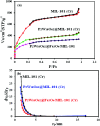K6P2W18O62 encapsulated into magnetic Fe3O4/MIL-101 (Cr) metal-organic framework: a novel magnetically recoverable nanoporous adsorbent for ultrafast treatment of aqueous organic pollutants solutions
- PMID: 35558601
- PMCID: PMC9089921
- DOI: 10.1039/c8ra06287k
K6P2W18O62 encapsulated into magnetic Fe3O4/MIL-101 (Cr) metal-organic framework: a novel magnetically recoverable nanoporous adsorbent for ultrafast treatment of aqueous organic pollutants solutions
Abstract
In this study, a Wells-Dawson type K6P2W18O62 polyoxometalate was encapsulated into the magnetic Fe3O4/MIL-101 (Cr) metal-organic framework and applied as a new magnetically recoverable ternary adsorbent to remove organic dyes from aqueous solutions. The as-prepared ternary magnetically recyclable hybrid (denoted as P2W18O62@Fe3O4/MIL-101 (Cr)) was characterized by FT-IR spectroscopy, powder X-ray diffraction (XRD), Raman spectroscopy, EDX, SEM, BET surface area, and magnetic measurements. The results showed the successful encapsulation of K6P2W18O62 (∼26.5 wt%) into the magnetic Fe3O4/MIL-101 (Cr) framework. The magnetic hybrid had a high specific surface area of 934.89 m2 g-1. The adsorption efficiency of this nanohybrid for the removal of methylene blue (MB), rhodamine B (RhB), and methyl orange (MO) from aqueous solutions was evaluated. The magnetic nanohybrid demonstrated the fast and selective adsorption of cationic dyes from mixed dye solutions. The adsorption rate and capacity of P2W18O62@Fe3O4/MIL-101 (Cr) were increased as compared with MIL-101 (Cr), P2W18O62, and Fe3O4/MIL-101 samples due to the increased electrostatic attraction. The effects of parameters such as the adsorbent dosage, temperature, dye concentration, and pH were investigated on the adsorption process. The adsorption kinetics was analyzed by the Freundlich, Langmuir, and Temkin isotherm models and pseudo-second-order and pseudo-first-order kinetics models, with the Langmuir isotherm and pseudo-second-order kinetic model found to be suitable to describe the equilibrium data. Also, the thermodynamic results of the nanohybrid indicated that the adsorption was an endothermic and spontaneous process. After the adsorption reaction, the magnetic nanohybrid could be easily separated and reused without any change in structure. Based on the results of this study, the nanohybrid was an efficient adsorbent for eliminating cationic dyes.
This journal is © The Royal Society of Chemistry.
Conflict of interest statement
There are no conflicts of interest to declare.
Figures















Similar articles
-
Dawson-Type Polyoxometalate Incorporated into Nanoporous MIL-101(Cr): Preparation, Characterization and Application for Ultrafast Removal of Organic Dyes.Acta Chim Slov. 2019 Feb;66(1):85-102. Acta Chim Slov. 2019. PMID: 33855468
-
An organic-inorganic hybrid nanomaterial composed of a Dowson-type (NH4)6P2Mo18O62 heteropolyanion and a metal-organic framework: synthesis, characterization, and application as an effective adsorbent for the removal of organic dyes.RSC Adv. 2020 Nov 2;10(66):40005-40018. doi: 10.1039/d0ra07042d. eCollection 2020 Nov 2. RSC Adv. 2020. PMID: 35520823 Free PMC article.
-
Preparation and characterization of novel polyoxometalate/CoFe2O4/metal-organic framework magnetic core-shell nanocomposites for the rapid removal of organic dyes from water.RSC Adv. 2020 Nov 2;10(65):39881-39893. doi: 10.1039/d0ra04603e. eCollection 2020 Oct 27. RSC Adv. 2020. PMID: 35515376 Free PMC article.
-
Magnetically separable Co0.6Fe2.4O4/MIL-101-NH2 adsorbent for Congo red efficient removal.Environ Sci Pollut Res Int. 2024 Feb;31(6):9764-9783. doi: 10.1007/s11356-023-31796-8. Epub 2024 Jan 9. Environ Sci Pollut Res Int. 2024. PMID: 38194177
-
Magnetically Recyclable Fe3O4/GO-NH2/H3PMo12O40 Nanocomposite: Synthesis, Characterization, and Application in Selective Adsorption of Cationic Dyes from Water.Acta Chim Slov. 2017 Dec;64(4):1005-1019. doi: 10.17344/acsi.2017.3731. Acta Chim Slov. 2017. PMID: 29318291
Cited by
-
A novel test device and quantitative colorimetric method for the detection of human chorionic gonadotropin (hCG) based on Au@Zn-salen MOF for POCT applications.RSC Adv. 2023 Apr 14;13(17):11751-11761. doi: 10.1039/d2ra07854f. eCollection 2023 Apr 11. RSC Adv. 2023. PMID: 37063717 Free PMC article.
-
Tailoring of Mesoporous Silica-Based Materials for Enhanced Water Pollutants Removal.Molecules. 2023 May 11;28(10):4038. doi: 10.3390/molecules28104038. Molecules. 2023. PMID: 37241778 Free PMC article.
-
Adsorptive removal of tetracycline and ciprofloxacin drugs from water by using a magnetic rod-like hydroxyapatite and MIL-101(Fe) metal-organic framework nanocomposite.RSC Adv. 2022 Nov 30;12(53):34438-34453. doi: 10.1039/d2ra06213e. eCollection 2022 Nov 29. RSC Adv. 2022. PMID: 36545621 Free PMC article.
-
High-performance hybrid supercapacitor-immobilized Wells-Dawson polyoxometalates on activated carbon electrodes.RSC Adv. 2023 Sep 6;13(38):26744-26754. doi: 10.1039/d3ra04478e. eCollection 2023 Sep 4. RSC Adv. 2023. PMID: 37681037 Free PMC article.
-
Ag NPs decorated on the magnetic rod-like hydroxyapatite/MIL-101(Fe) nanocomposite as an efficient catalyst for the reduction of some nitroaromatic compounds and as an effective antimicrobial agent.RSC Adv. 2023 May 4;13(20):13683-13697. doi: 10.1039/d3ra01180a. eCollection 2023 May 2. RSC Adv. 2023. PMID: 37152578 Free PMC article.
References
LinkOut - more resources
Full Text Sources
Miscellaneous

